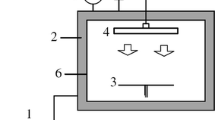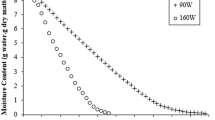Abstract
Button mushroom slices were dried using freeze-drying (FD) and freeze-drying combined with microwave vacuum drying (FD + MVD) methods. Drying parameters including drying temperatures (20, 30, and 40 °C), chamber pressures (70, 100, and 130 Pa) and material layer thicknesses (single, double, and triple) during FD process, and microwave power densities (20, 40, and 60 W/g) and material layer thicknesses (single, double and triple) during MVD period of FD + MVD process, were investigated for their drying characteristics. The FD and FD + MVD products were then rehydrated at two temperatures (20 and 70 °C). Different mathematical models were tested with the drying and rehydration behaviors of button mushroom slices, and the effective diffusivities (D eff) in the FD and FD + MVD processes were also calculated. The results indicated that based on the statistical tests, the Page model and logarithmic model provided the best fit for FD (in both FD and FD + MVD processes) and MVD (in FD + MVD process) curves, respectively. The regression equations obtained from selected models can accurately predict the relationships between moisture ratio (MR) and time (t). Furthermore, the D eff values of the MVD period in FD + MVD process (2.318–5.565 × 10−5 m2/s) were about ten times greater than those in FD process (1.291–3.389 × 10−6 m2/s). In addition, the Peleg model gave a better fit for rehydration conditions applied in both FD and FD + MVD products. The values of equilibrium moisture content (W e) of FD + MVD products were almost similar to those of FD products, which indicated that the rehydration capacities of the two dehydrated products were comparable.




Similar content being viewed by others
References
Ah-Hen, K., Zambra, C., Aguëro, J., Vega-Gálvez, A., & Lemus-Mondaca, R. (2013). Moisture diffusivity coefficient and convective drying modelling of murta (Ugni molinae Turcz): Influence of temperature and vacuum on drying kinetics. Food and Bioprocess Technology, 6(4), 919–930.
Babić, J., Cantalejo, M. J., & Arroqui, C. (2009). The effects of freeze-drying process parameters on broiler chicken breast meat. LWT - Food Science and Technology, 42(8), 1325–1334.
Chawla, C., Kaur, D., Oberoi, D., & Sogi, D. (2008). Drying characteristics, sorption isotherms, and lycopene retention of tomato pulp. Drying Technology, 26(10), 1257–1264.
Crank, J. (1975). The mathematics of diffusion. Oxford: Clarendon Press.
Cui, Z. W., Sun, L. J., Chen, W., & Sun, D. W. (2008). Preparation of dry honey by microwave–vacuum drying. Journal of Food Engineering, 84(4), 582–590.
Cunningham, S. E., McMinn, W. A. M., Magee, T. R. A., & Richardson, P. S. (2008). Experimental study of rehydration kinetics of potato cylinders. Food and Bioproducts Processing, 86(1), 15–24.
Dadali, G., Demirhan, E., & Özbek, B. (2008). Effect of drying conditions on rehydration kinetics of microwave dried spinach. Food and Bioproducts Processing, 86(4), 235–241.
Demirhan, E., & Özbek, B. (2010). Drying kinetics and effective moisture diffusivity of purslane undergoing microwave heat treatment. Korean Journal of Chemical Engineering, 27(5), 1377–1383.
Dı́az, G. R. Z., Martı́nez-Monzó, J., Fito, P., & Chiralt, A. (2003). Modelling of dehydration-rehydration of orange slices in combined microwave/air drying. Innovative Food Science & Emerging Technologies, 4(2), 203–209.
Donsì, G., Ferrari, G., & Matteo, D. I. (2001). Utilization of combined processes in freeze-drying of shrimps. Food and Bioproducts Processing, 79(3), 152–159.
Doymaz, İ., & İsmail, O. (2011). Drying characteristics of sweet cherry. Food and Bioproducts Processing, 89(1), 31–38.
Doymaz, İ., Tugrul, N., & Pala, M. (2006). Drying characteristics of dill and parsley leaves. Journal of Food Engineering, 77(3), 559–565.
Duan, X., Zhang, M., & Mujumdar, A. S. (2007). Study on a combination drying technique of sea cucumber. Drying Technology, 25(12), 2011–2019.
Franks, F. (1998). Freeze-drying of bioproducts: Putting principles into practice. European Journal of Pharmaceutics and Biopharmaceutics, 45(3), 221–229.
George, J. P., & Datta, A. K. (2002). Development and validation of heat and mass transfer models for freeze-drying of vegetable slices. Journal of Food Engineering, 52(1), 89–93.
Giri, S. K., & Prasad, S. (2007). Drying kinetics and rehydration characteristics of microwave-vacuum and convective hot-air dried mushrooms. Journal of Food Engineering, 78(2), 512–521.
Henderson, S., & Pabis, S. (1961). Grain drying theory I. Temperature effect on drying coefficient. Journal of Agricultural Engineering Research, 6(3), 169–174.
Hu, Q. G., Zhang, M., Mujumdar, A. S., Xiao, G. N., & Sun, J. C. (2006). Drying of edamames by hot air and vacuum microwave combination. Journal of Food Engineering, 77(4), 977–982.
Huang, L. L., Zhang, M., Wang, L. P., Mujumdar, A. S., & Sun, D. F. (2012). Influence of combination drying methods on composition, texture, aroma and microstructure of apple slices. LWT - Food Science and Technology, 47(1), 183–188.
Joykumar Singh, N., & Pandey, R. K. (2012). Convective air drying characteristics of sweet potato cube (Ipomoea batatas L.). Food and Bioproducts Processing, 90(2), 317–322.
Karathanos, V. T. (1999). Determination of water content of dried fruits by drying kinetics. Journal of Food Engineering, 39(4), 337–344.
Kim, S. S., & Bhowmik, S. R. (1995). Effective moisture diffusivity of plain yogurt undergoing microwave vacuum drying. Journal of Food Engineering, 24(1), 137–148.
Lewis, W. (1921). The rate of drying of solid materials. Industrial & Engineering Chemistry, 13(5), 427–432.
Liapis, A., Pim, M., & Bruttini, R. (1996). Research and development needs and opportunities in freeze drying. Drying Technology, 14(6), 1265–1300.
Lin, Y. P., Tsen, J. H., & King, V. A. E. (2005). Effects of far-infrared radiation on the freeze-drying of sweet potato. Journal of Food Engineering, 68(2), 249–255.
Litvin, S., Mannheim, C. H., & Miltz, J. (1998). Dehydration of carrots by a combination of freeze drying, microwave heating and air or vacuum drying. Journal of Food Engineering, 36(1), 103–111.
Liu, J., Jia, L., Kan, J., & Jin, C. H. (2013). In vitro and in vivo antioxidant activity of ethanolic extract of white button mushroom (Agaricus bisporus). Food and Chemical Toxicology. doi:10.1016/j.fct.2012.10.014.
Maskan, M. (2001). Drying, shrinkage and rehydration characteristics of kiwifruits during hot air and microwave drying. Journal of Food Engineering, 48(2), 177–182.
McMinn, W. A. M. (2006). Thin-layer modelling of the convective, microwave, microwave-convective and microwave-vacuum drying of lactose powder. Journal of Food Engineering, 72(2), 113–123.
Moreira, R., Chenlo, F., Chaguri, L., & Fernandes, C. (2008). Water absorption, texture, and color kinetics of air-dried chestnuts during rehydration. Journal of Food Engineering, 86(4), 584–594.
Oliveira, F., Sousa-Gallagher, M. J., Mahajan, P. V., & Teixeira, J. A. (2012). Development of shelf-life kinetic model for modified atmosphere packaging of fresh sliced mushrooms. Journal of Food Engineering, 111(2), 466–473.
Page, G. E., (1949). Factors influencing the maximum rates of air drying shelled corn in thin layers. MS thesis, Purdu University.
Pei, F., Yang, W. J., Shi, Y., Sun, Y., Mariga, A., Zhao, L. Y., Fang, Y., Ma, N., An, X. X., & Hu, Q. H. (2013). Comparison of freeze-drying with three different combinations of drying methods and their influence on colour, texture, microstructure and nutrient retention of button mushroom (Agaricus bisporus) slices. Food and Bioprocess Technology. doi:10.1007/s11947-013-1058-z.
Peleg, M. (1988). An empirical model for the description of moisture sorption curves. Journal of Food Science, 53(4), 1216–1217.
Ratti, C. (2001). Hot air and freeze-drying of high-value foods: a review. Journal of Food Engineering, 49(4), 311–319.
Sacilik, K. (2007). Effect of drying methods on thin-layer drying characteristics of hull-less seed pumpkin (Cucurbita pepo L.). Journal of Food Engineering, 79(1), 23–30.
Seth, D., & Sarkar, A. (2004). A lumped parameter model for effective moisture diffusivity in air drying of foods. Food and Bioproducts Processing, 82(3), 183–192.
Shishehgarha, F., Makhlouf, J., & Ratti, C. (2002). Freeze-drying characteristics of strawberries. Drying Technology, 20(1), 131–145.
Simal, S., Femenia, A., Garau, M. C., & Rosselló, C. (2005). Use of exponential, Page's and diffusional models to simulate the drying kinetics of kiwi fruit. Journal of Food Engineering, 66(3), 323–328.
Song, X. J., Zhang, M., Mujumdar, A. S., & Fan, L. (2009). Drying characteristics and kinetics of vacuum microwave-dried potato slices. Drying Technology, 27(9), 969–974.
Srikiatden, J., & Roberts, J. S. (2006). Measuring moisture diffusivity of potato and carrot (core and cortex) during convective hot air and isothermal drying. Journal of Food Engineering, 74(1), 143–152.
Taheri-Garavand, A., Rafiee, S., & Keyhani, A. (2011). Study on effective moisture diffusivity, activation energy and mathematical modeling of thin layer drying kinetics of bell pepper. Australian Journal of Crop Science, 5(2), 128–131.
Therdthai, N., & Zhou, W. (2009). Characterization of microwave vacuum drying and hot air drying of mint leaves (Mentha cordifolia Opiz ex Fresen). Journal of Food Engineering, 91(3), 482–489.
Uribe, E., Vega-Gálvez, A., Di Scala, K., Oyanadel, R., Saavedra Torrico, J., & Miranda, M. (2011). Characteristics of convective drying of pepino fruit (Solanum muricatum Ait.): application of Weibull distribution. Food and Bioprocess Technology, 4(8), 1349–1356.
Vega-Gálvez, A., Miranda, M., Clavería, R., Quispe, I., Vergara, J., Uribe, E., Paez, H., & Di Scala, K. (2011). Effect of air temperature on drying kinetics and quality characteristics of osmo-treated jumbo squid (Dosidicus gigas). LWT - Food Science and Technology, 44(1), 16–23.
Vega-Gálvez, A., Notte-Cuello, E., Lemus-Mondaca, R., Zura, L., & Miranda, M. (2009). Mathematical modelling of mass transfer during rehydration process of Aloe vera (Aloe barbadensis Miller). Food and Bioproducts Processing, 87(4), 254–260.
Walton, K., Walker, R., & Ioannides, C. (1998). Effect of baking and freeze-drying on the direct and indirect mutagenicity of extracts from the edible mushroom Agaricus bisporus. Food and Chemical Toxicology, 36(4), 315–320.
Wang, Z., Sun, J., Chen, F., Liao, X., & Hu, X. (2007). Mathematical modelling on thin layer microwave drying of apple pomace with and without hot air pre-drying. Journal of Food Engineering, 80(2), 536–544.
Zielinska, M., Zapotoczny, P., Alves-Filho, O., Eikevik, T. M., & Blaszczak, W. (2013). A multi-stage combined heat pump and microwave vacuum drying of green peas. Journal of Food Engineering, 115(3), 347–356.
Acknowledgments
The authors acknowledge financial support from China Agriculture Research System (CARS-24).
Author information
Authors and Affiliations
Corresponding author
Rights and permissions
About this article
Cite this article
Pei, F., Shi, Y., Mariga, A.M. et al. Comparison of Freeze-Drying and Freeze-Drying Combined with Microwave Vacuum Drying Methods on Drying Kinetics and Rehydration Characteristics of Button Mushroom (Agaricus bisporus) Slices. Food Bioprocess Technol 7, 1629–1639 (2014). https://doi.org/10.1007/s11947-013-1199-0
Received:
Accepted:
Published:
Issue Date:
DOI: https://doi.org/10.1007/s11947-013-1199-0




